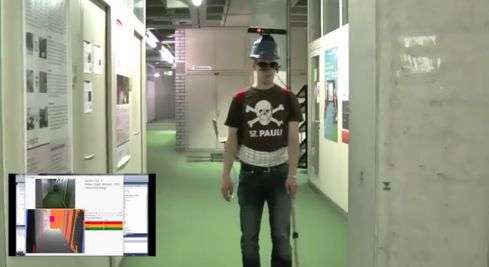March 18, 2011 weblog
Kinect to help the blind 'see' in augmented reality

(PhysOrg.com) -- It seems like there are no shortage of uses for the Kinect system. The device, which was initially created by Microsoft as an add-on to its popular Xbox 360 video game console, to allow users to ditch the controller, has been getting around. Now, it has been integrated into a system designed to help the blind.
The system in question, which was designed by graduate students at the Universität Konstanz in Germany, has been dubbed the NAVI, or Navigational Aids for the Visually Impaired.
NAVI works something like this. The infrared camera from a Kinect system is mounted to a helmet that can be worn by a bilnd person. The visual data from that camera is turned into a set of audio instructions that are then transmitted to the wearer via a wireless headset. The system also features a standard camera added as well, allowing for a kind of three-camera stereoscopic vision. Certain items, such as door, will trigger events, such as a countdown, to prevent users from walking into the aforementioned door, in a kind of augmented reality.
The goal is to be able to give a blind person warnings about potential obstructions and directions to navigate in set spaces, at a longer distance than the current systems in place. Though this reporter for one, thinks that a Kinect will be much more of a supplement to seeing eye dogs than a replacement for them.
The system is also paired with a vibro-tactile arduino system in the belt, that will most likely act as a warning system, should an obstacle come perilously close to the user. No plans for commercial release of the system have been mentioned at this time.
More information: hci.uni-konstanz.de/blog/2011/03/15/navi/?lang=en
© 2010 PhysOrg.com




















